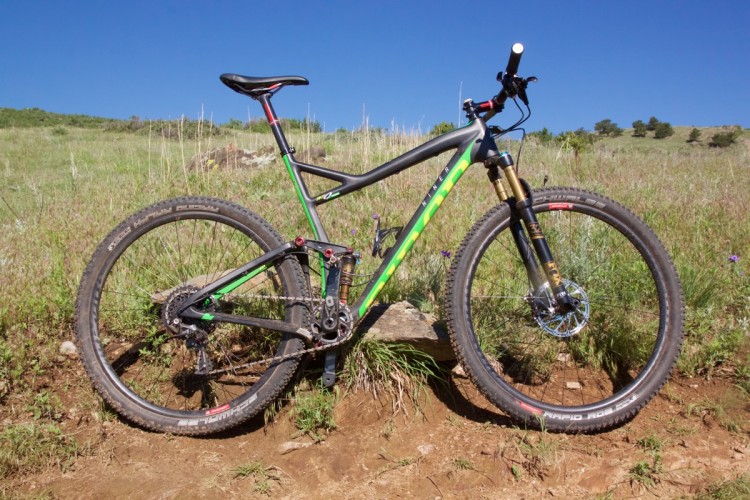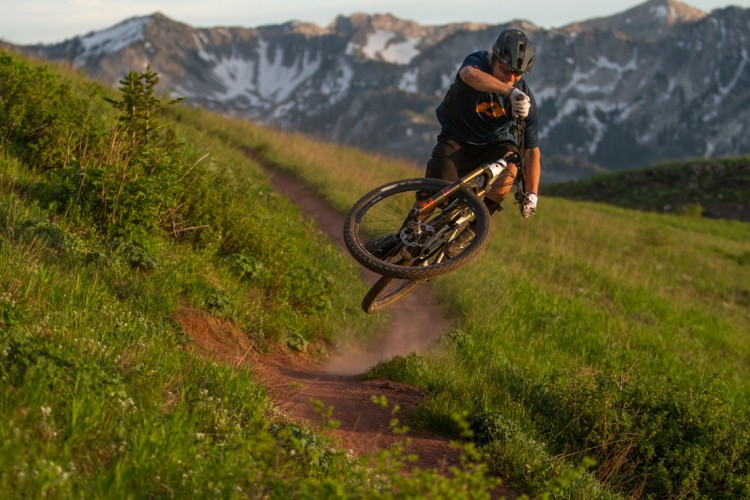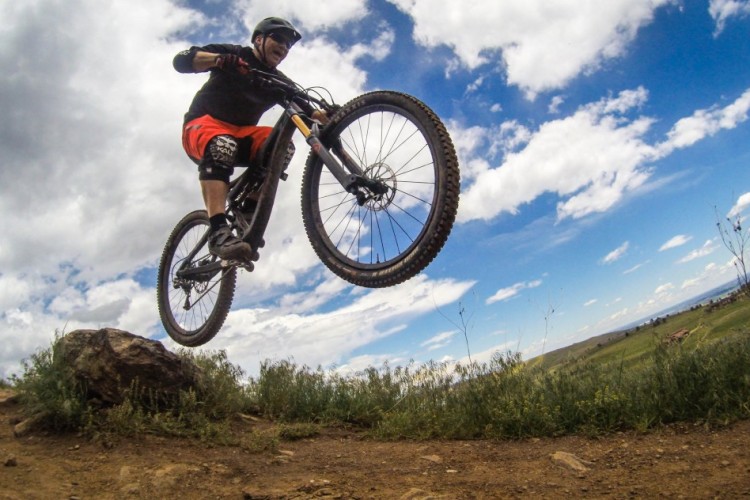
Just two years ago Pivot introduced an updated version of the heavy-hitting Firebird. The 2017 model debuted in the summer of 2016 sporting 170mm of front and rear travel on a 27.5-inch platform with Boost spacing.
The Firebird has progressed quickly in the past two years. Big wheels have all but taken over the enduro market and they staked their claim on the Firebird. It’s part consumer-demand and part athlete-demand. Twenty-nine-inch wheels on a long-travel bike turn big rocks into little rocks like a prisoner on a chain gang.

For the new version, the rear travel was dialed back to 162mm, but the bike still has a 170mm-travel fork. The seat angle got steeper and the head tube angle actually stayed right where it was at 65-degrees. Somehow though, despite adding a bigger wheel size, the chainstays are the same 430mm long. Seeing as how the geometry has stayed very close to the previous version, the highlight is obviously the addition of 29-inch wheels.
The aesthetic of the Firebird is different than the curvy S-tubes that swoop up and down most Pivot bikes. The top and down tube are square and blocky and straight as an arrow.

Pivot sent over the new Firebird in the middle of October and I got some solid descending in before the trails got packed full of snow and ice.
Specs (size medium tested)
- 162mm frame travel / 170mm fork travel
- 29-inch wheels
- HTA: 65-deg. low, 65.5-deg. high
- Seat angle: 75.75-deg low, 76.25-deg high
- BB height: 348mm in low, 353.8mm in high
- Standover height (M): 689mm
- Wheelbase (M): 1216.7mm
- Reach: 454mm in low, 459mm in high
- Weight (M): 32lbs, w/o pedals
- Price: $5,100 – $9,200. ($7,900 tested)

On the trail

My first ride out on the Firebird seemed like a perfect match for the bike. The South Boundary trail in New Mexico is a shuttled ride from Angel Fire to Taos. We clocked about 2,400 feet of climbing that day and more than twice that in descending. The route was much more pedally than I anticipated throughout most of the trail until the last few miles, so only about 20% of the entire trail ended up being a good match for the bike. But, that last 20% was a hell of a lot of fun.
Aside from the New Mexico riding, I’ve had the bike out on my home trails in Golden, Colorado for two months or so and have been hitting the rougher stuff like Dakota Ridge, White Ranch, and Apex. It didn’t take me long to find out where the bike shines and where it doesn’t.
Climbing

The burning question on these long-travel 29ers is, “how do they climb?” They’re made for enduro and that entails sometimes long and arduous, but often not very technical climbing.
In some areas, I was surprised at this big bike’s climbing capabilities and in other areas, I wasn’t surprised at all.
I think if readers are very concerned about the way that this bike climbs, then it’s probably not the bike for them. On long and sustained climbs, it feels like pedaling an almost seven-inch travel 29er. It’s just not going anywhere fast — uphill, that is. It’s not that the Firebird gets lost in the rear travel, or isn’t efficient, but it does feel like pedaling a lot of bike around and it’s not an exciting bike to climb with. This probably shouldn’t surprise anyone.
The flip side is taking the bike through tight and technical uphill challenges, where unfortunately-placed rocks usually mean stalling out and unclipping. Or, switchbacks that require a two-point turn by taking a foot off. The Firebird excelled in these situations, and that surprised me. The bike has a very long wheelbase and I assumed that the length would take away from the the bike’s technical climbing ability, but it doesn’t.

The Firebird feels very confident crawling its way up technical rock gardens. The wheels help put a larger footprint down, the suspension is plush and contours to terrain, and the geometry puts me in a great position, which leads me to the next point of discussion.
The geometry on the Firebird is excellent. Even climbing in the bike’s low position that sets it at a 75.75-degree seat angle, and a 65-degree head angle still feels like a manageable seating position and not a hyper light front end. In the high position, it feels even steeper, although it was left in the low position for the majority of my test, since that’s where most of the potential for the Firebird lies.
If you’ve been paying a lot of attention to this bike since its release, you might’ve noticed that the seat angle in the geometry has changed. In our news about the Firebird 29, we listed a 74.5-75-degree seat angle.
Pivot has since change the numbers online to show a 75.75-76.25-degree seat angle after Bike Mag noted in a review that 74.5-degrees is slack compared to a lot of other long-travel 29ers that have been released this year.
Pivot acknowledged that they had previously measured an effective seat angle for a roughly six-foot rider, and while that appears slacker than a lot of other bikes on the market, many of the other brands are measuring the seat angle from a shorter distance, which results in a steeper angle on paper.
To be fair to themselves when compared to the competition, Pivot is now measuring its seat angles to a lower position — a horizontal line straight back from the head tube, higher than the seat collar, but lower than the previous spot.
“It’s making it more accurate in an apples-to-apples comparison,” says Ron Koch of Pivot, about the change. “Ideally, no one would ever know what the seat angle was and would ride it and say what they felt, but that wasn’t happening.”
Even knowing the 74.5-degree effective seat angle of the Firebird out on the climbs, I never found my torso to lean back too much, or the front end to be too light. Again, I think the geometry and the climbing position of the bike are a highlight, and the position feels like a near 76-degree seat angle.
Descending

Now, back to that final stretch of the South Boundary trail. The descending grade was around 13% for the whole section and full of one to three-foot drops and steep rocky parts with loose corners. This is where the Firebird 29 shines.
Back at home, I didn’t waste any time taking the bike out on mild, blue-rated trails. They weren’t a great fit for the manners of the Firebird and it took me some time to get used to its manners, too.

I’m used to bouncing around a little bit and popping off roots and lips, but that’s not what the Firebird does best. The Firebird could care less about what’s in its way. It plows through big rocks and straight over roots and doesn’t get hung up the slightest on square hits.
More playful characteristics could’ve been tuned in with a different X2 shock, but the Performance edition components equipped on my test bike only allowed for low speed compression and rebound adjustments.
Once I got used to the handling of the Firebird, I stopped caring about playing around and just straight-lined every technical section as fast as I could, sans brakes. With its linear, DH-feeling suspension, the bike ramps up later in the travel and doesn’t get bucked around no matter what you’re riding through.
The thick-tubed carbon makes for a stiff frame that finds its line every time through corners and changes direction without attitude.
The moment I realized the full potential of the Firebird was on a 21% grade, 30-yard sprawled out rock garden dubbed the Wall on Deer Creek Canyon, in Littleton, CO. See a user-uploaded video of it on our Deer Creek trail page for context, or a Nate Hills video with much smoother footage. Usually I pick my way through it at speed on my 650B full-suspension and get a respectable time through the segment.

On the Firebird, I absolutely smashed my former time on the 94-foot segment by nine seconds while feeling more together than ever, again proving that steep and chunky trails are what this bike is made for.
Component check

The Firebird build that I’ve been on is a bit of a mashup. The Pro XT build equips it with Shimano XT brakes, an XT shifter and cassette, an XTR derailleur, and a Race Face Aeffect crank set. This Pro XT build is $6,600, but mine also has the carbon Reynolds wheels with I-9 hubs for an added cost of $1,300. For another $125 buyers can get the Fox Factory X2 that makes the suspension a bit more tunable, and could make the bike feel a little more lively.
I think to hit a lower price point, Pivot was smart to put the budget Aeffect crank on since a more premium crank adds more price than performance.

I do like the double upshift on the XT shifter, since that can make a difference when the terrain changes quickly.
The 150mm KS Lev SI dropper post worked fine, but is already seeing a little bit of sag in it and the post collar kept coming loose.
Of course everyone is talking about Super Boost Plus, though. I don’t believe that Pivot introduced this hub to trail and enduro bikes to complicate everyone’s lives even more, but rather to achieve the geometry they wanted the Firebird to have. Part of that includes short chainstays, which Super Boost Plus makes attainable on a long-travel 29er, with leftover room for meaty tires.

Devinci did the same thing this summer with the Spartan 29 and it may be something we see on more long-travel 29ers.

On the build I tested, I’d ride the Reynolds and I-9s for however long I owned the bike, if I was a buyer. The $5,200 base model has a Sun Ringle wheelset which may leave a buyer craving a better set down the line. Unfortunately Super Boost Plus will probably complicate the search when it comes to wheels.
Sizing
At 5’8″ I could have fit into a size small (5’4″ – 5’9″) or a medium (5’8″ – 5’11”) comfortably. The medium reach was the longest I’ve ridden, maybe ever, at 455mm. Even the size small is more what I’m used to at about 429mm. Riding a size small could have resulted in a bike I could throw around more, but I still like the roominess of the medium and it didn’t feel excessively long for me.
Who’s it for?
The Firebird 29 isn’t for everyone. While it is one of the most badass looking bikes to drop in 2018 and that alone may trigger a lot of people to buy it, it’s not enjoyable on every trail, or even the majority of trails.
It’s fun on rough and steep black and double black diamond trails that resemble blown-out minefields, where the ground-hugging suspension keeps you in a straight line at high speeds. Personally, I like those trails, and would take out the Firebird on them every time if I could, but they aren’t the trails that I find myself on every time out.
But, if you’re a frequent lift rider or enduro racer, or often find yourself in the back of a shuttle heading up a fire road, the Firebird is more than worth the consideration.
Conclusion

The Firebird isn’t an all-rounder. The Switchblade or Mach 5.5 are much more versatile Pivots that can handle anything from trail rides to enduro races.
This puts the Firebird 29 in a class of its own, and earns As on steep descents, big rocks, and tall drops and gets extra credit by doing it faster than almost anyone else.






















3 Comments
Dec 12, 2018
Dec 12, 2018
Dec 14, 2018